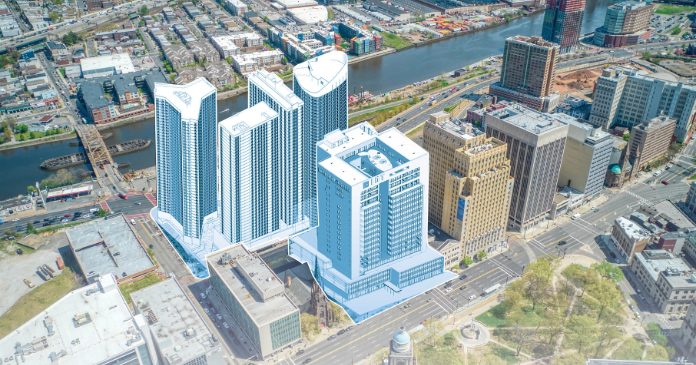“You’re already home,” is the message Village Green Cos. hopes to convey as soon as prospective residents enter one of the company’s rental communities, and the landscape that greets the potential renters is key to the company’s historically concentrated focus on curb appeal. At Village Green Cos.’ four distinct apartment brands, each of which features its own landscape architecture theme, the apartment developer, owner and manager says “welcome home” with various combinations of plantings like switch grass and viburnum, birch and ornamental pear trees, black-eyed susans and “a host of golden daffodils” that would delight William Wordsworth’s ghost.
Forty-five seconds is not very long, but that’s how fast a potential renter could decide whether or not to lease an apartment, a concept Village Green Cos.’ Director of Landscape Architecture Barry Burton learned from a real estate agent years ago, when he was shopping for a home in Chicago. “Since she told me that, I’ve lived by it and found it’s true,” said the urban forestry expert, who joined the Midwestern company three years ago, when he left his position as assistant to Chicago Mayor Richard M. Daley, for whom he oversaw landscape initiatives city-wide. Burton is a perfect fit with Village Green’s current focus on urban product, a far cry from the suburban garden apartments that were the company’s bread and butter for 40 years.
And, even with its current urban focus, the company that was founded in 1919 by current CEO Jonathan Holtzman’s grandfather and was christened Village Green Management in 1966, but evolved over the years to become Village Green Companies, remains true to its name. Today, Village Green Companies is the umbrella under which its four main operating entities–Village Green Management Company, Village Green Residential Properties, Village Green Construction and Village Green Communications–function to provide a full-service approach to real estate transactions. “We also focus on resident retention by keeping the landscapes beautiful and well-maintained and finding ways to do that economically and in an environmentally friendly way,” Burton said last month, adding that the extra effort Village Green puts into its greenery creates a more homelike feel. “If the landscape looks like something you would see at a resort or at a higher-end condominium community, you’re creating a place that feels more like a home than it does a rental,” he said.
Over the years, Village Green has developed its four distinct brands–Village Green, Village Park, Regents Park and City Apartments–to appeal to a variety of renters. That brand-splitting strategy, which is common in the hospitality industry, is unique in the multifamily space. The company, which currently operates nearly 35,000 apartments in more than 135 apartment communities of which the company owns 33 percent and provides third-party management services at the other 67 percent, built its first branded Village Green Apartments community in a suburb of Detroit 41 years ago. That brand consists of suburban infill, garden-style and mid-rise communities designed to appeal to renters-by-choice seeking resort-quality amenities and services.
The most recently constructed Village Green Apartments asset was completed in Rochester, Mich., seven years ago, with no more new suburban development contemplated in the near future, said Village Green Cos. COO George Quay, who left the hospitality industry in 1989 to run Village Suites, Village Green’s corporate housing arm, until that division was purchased by Global Business Resources, Inc. in 1998. Quay left Village Green to head up the corporate housing operation for its new owner, but returned to Village Green Cos. in September 2000 as president and COO, after his predecessor Terry Schwarz resigned.
At about the same time, Village Green started concentrating its development efforts on two primary brands–City Apartments and Village Park Apartments, with the urban brand being the primary focus. Since the Village Park brand was launched in Troy, Mich., in 1989, the company has purchased 32 communities and renovated them to affordable luxury Village Park Apartments designed to attract the 20- and 30- somethings demographic. The most recent addition to the Village Park collection is underway in Hoffman Estates, a suburb northwest of Chicago, where Village Green bought a community with no amenities for approximately $67,000/unit and started renovation construction last month. Quay expects to spend a total of $17,000/unit on improvements that will include in-unit spruce-ups, building a brand new clubhouse and a pool with a sandy beach. The beach is a first for Village Green’s mostly Midwestern portfolio, made possible, Burton said, by innovations in pool design that keep the grit from ruining the filtration system. “Again, this sets us apart from other apartment communities,” he said.
Village Green Apartments is the most conventional of the company’s four brands, which is reflected in the landscape design. “We’ll stick with more traditional flowers like begonias and colors that really blend together, like pinks, white, blues and maybe a hint of yellow. What you’d see in a traditional flower garden,” said Burton, who makes regular visits to the more than 135 rental communities Village Green owns and manages throughout the Midwest, and in the Portland and Dallas areas, where he makes curb-appeal improvement recommendations and other suggestions for renovating aging landscapes.
“It’s not uncommon in new construction to over plant to make something look great on the grand opening day and then you have to deal with what happens 15 years later. On other sites, it might be a situation where not very much was planted in the first place and maybe there’s a need to add more to bring more vivacity to an area around the pool or clubhouse,” he said of his experiences with the more mature communities he visits.
The upscale suburban 299-unit Regents Park of Troy that delivered first units in 2001, is the first of that brand to be built by the company. A 60-unit second phase is scheduled to break ground in spring of 2008. “Regents is a very unique brand, catering to very high-end of prospects. We’ve developed it very upscale, with luxury condo finishes,” he said. Village Green’s Regents Park brand operates like a five-star hotel with conveniences such as a full-time concierge, who has relationships with different venues for tickets, restaurant reservations and other personal services for residents.
Regents Park of Troy was built primarily for empty nesters, who have their roots in Michigan, but live elsewhere much of the year and want the flexibility of a rental with very high levels of finishes, amenities and services without the burden of home or condo ownership, Quay said.
That community is embellished with flora that enhance its distinguished ambience. “We use flowers in ranges of pinks, whites and blues and put in ornamental pear, and assorted flowering perennials like perovskia, black-eyed susans and a lot of viburnum shrubs and hedges of privet or yew to create an English look,” said Burton, who spend five months in Europe after he graduated from Michigan State University’s College of Urban Planning and Landscape Architecture in 1987. When he returned to the U.S., he became a city planner for New Rochelle, N.Y., followed by a similar position in Winnetka, Ill. He left the Winnetka job to become landscape architect for Canton Township, Mich., before becoming the zoo horticulturist for the Detroit Zoological Institute.
“It was the zoo that really expanded my appreciation of horticulture and creating naturalistic exhibits with an environmental purpose, such as earth-friendly gardening and providing habitat for butterflies and birds,” he said.
His enthusiasm for urban forestry grew during his time with Daley’s office in Chicago and has grown stronger during his years with Village Green, which began to focus seriously on adding environmentally friendly green elements to the communities the company develops just before Burton arrived. When he started with the company, MDA City Apartments already was underway, with plans to become the Windy City’s first LEED certified green apartment building. “And it’s been that way ever since I’ve been here, which was great because when I left the mayor’s office, they also were moving in a very ecologically friendly way of doing things,” said Burton.
The 190-unit MDA City Apartments, the ninth built by Village Green since that brand’s launch in 1999 when Fisher Building City Apartments broke ground in Chicago, was completed early last year and currently is an astonishing 100 percent occupied with a waiting list. The 24-story upscale historically repositioned Medical Dental Arts building that was built in 1926 to house the Windy City’s medical elite and later was home to the Joffrey Ballet, is a model of environmental friendliness. Just a half-block from one of Chicago’s rail mass transit system stations, the community boasts double-pane oversize windows that keep cold out and let sunlight in, sinks that conserve water, a four-pipe heating and cooling system that uses renewable energy, and bamboo, salvaged timber and concrete in communal areas. A green roof reduces storm-water entering the city’s sewer system by absorbing it into the soil and irrigating the plants.
Construction cost was approximately $190,000/unit, with financing coming from debt partner Bank of America and equity partner Marc Realty, a Chicago realty company that was part owner of the building, said Quay. Another, Randolph Tower City Apartments is under development in Chicago, while plans for yet another City Park Apartment deal are in the works in Ann Arbor, Mich., and Quay is actively pursuing, but not ready to talk about, a couple of other urban developments, as well.
In Minneapolis, the recently opened 158-unit Lake Calhoun City Apartments and the 213-unit, five- to six-story Eitel Building City Apartments that is underway there and should deliver first units in January of 2008, also will be green buildings. Both of those properties will have underground tanks to filter sediments and control water quality before it leaves the property, contributing to a cleaner environment. In addition, landscaping will incorporate native plants and trees to provide noise abatement, cooling shade in the summer and wind protection for the building in the winter. Eitel will include an outdoor boardwalk made of recycled plastic and the company is looking into using recycled glass, in combination with cement, as a paving alternative there.
All of which is part of Holtzman’s dedication to encouraging a more verdant environment, based on his belief that green buildings are “no longer the wave of the future, but where the future will live,” which makes it a lot easier for Burton to do the job he loves. “It’s wonderful from my perspective because it is almost an intangible when you talk about why you go to this length to put in landscape. Fortunately, our owner believes it creates better business for us and is the foundation of what Village Green stands for and it’s built into our name. So, I don’t have to spend a good deal of my time trying to prove that to others because the owner believes in it,” said Burton, who is having a wonderful time turning rooftops into Sky Parks and creating micro-climates in courtyards at City Apartments and enhancing Village Park communities to attract the post-college crowd of echo boomers.
For the youthful demographic, the look is a little trendier, with sleeker furniture at the pool and flowers that you wouldn’t see in your mother’s garden, he said. We’ll do orange impatiens and we’ll throw in purple petunias and we’ll put in some flowers that grow to five or six feet tall and just give it a kind of wild look,” he said, adding that the clubhouse looks modern and the unit interiors could easily be used for a reality show on MTV.
The Hoffman Estates project should be finished by June of 2008 and the company is aggressively looking for more Village Park opportunities. “We’re working our broker network very actively. We have a multitude of relationships with individual owners that we’ve forged over the years and, when they’re in a position to sell, we hopefully are going to be their first contact,” said Quay. The company has an overall budget of four to six new acquisitions a year and currently has $325 million of development in production, which is a pretty good barometer of what Village Green Cos. is looking to have as an ongoing pipeline number.
At the company’s City properties, Burton is going with the trendy Asian look in outdoor decor. “Right now it’s a little bit on the Japanese side “cool, calm and quiet,” he said, explaining that his first priority is finding plants that will grow in highly polluted city air on top of a high-rise, where there’s not much soil. “I just cram things together and let it all cascade out and grow. It’s wild, kind of like Village Parks, but very urban, so we use tougher plants there,” he said. “We might use things like sedum, which is almost in the cactus family and has very thick leaves that hold water well, so they’re very drought-tolerant plants, which we like to use in urban areas.
The green roofs that Village Green is installing atop the City properties provide not just beauty, but also can lower the temperature of the floor below them by 20 to 30 percent, said Burton. “Green technology’s come a long way. It’s been simplified and, instead of being an expensive, luxury item, it now looks just like trays of ground cover that get placed on top of the building and they’re mostly sedums, which can survive anything.
“If there’s a heavy drought, they go dormant, but as soon as the rain comes, they come back. Irrigation isn’t even necessary for that kind of green roof,” he said, explaining that Village Green high-rises actually have two kinds of green roofs — one that is totally eco- oriented and the other where lawns, barbecue areas and trees and shrubs combine to create a recreational sky park. In some of its historic restoration projects in Chicago, the company also is restoring little plots of Illinois’ disappearing native prairie that once covered much of the state with grasses and brilliant wildflowers. Development and farming have reduced the Land of Lincoln’s original prairie land to just two percent of the sea of grass the pioneers saw when they first arrived.
“We use quite a few plants that are native to the prairies that will survive on the rooftops, because the prairies were pretty harsh environments, especially the rocky dolomite prairies, where you’ll find that plants can survive drought and flood at the same time. We use a lot of panicum, which is also called switch grass. It looks beautiful, especially this time of year, when the seed pods are all forming on it just swaying in the wind like wheat. And, of course black-eyed susans and purple cone flowers are favorites of ours because they’re so hardy and they give prolific color. I’ve even snuck in things like goldenrod,” he said.
How can the company afford to take such great pains with its landscape and still be profitable? Burton says his department extends its landscaping dollar by encouraging property managers to plan early for the coming season in order to secure the best plants at the most economical price. Village Green extends the landscaping dollar farther by using plants like daffodils that come back year after year and grow in strength over time allowing for the biggest impact at the best cost, rather than pansies, which must be replaced every year.
His shrub rejuvenation program, he says, prolongs the landscaping’s usefulness. “You can let a shrub grow to the point where it’s obsolete, or you can prune a shrub practically to death. Either way, you have to replace it and the cost is about $55 to $80 per shrub. Or, about every five to seven years, you can go and cut shrubs down to almost ground level and let them re-grow, as if you’ve just planted a new shrub and the cost of that is about $10 per shrub,” Burton explained. By using preferred landscape vendors with horticulturists onboard, who can schedule the right time for that to happen, the company can save tens of thousands of dollars because operating expenses do not turn into capital expenses, he said.
He also encourages all Village Green’s site managers to budget for proper tree pruning because a tree that’s thinned out every five to ten years is less likely to fall over than a tree that hasn’t been pruned properly and catches the wind in its dense leaves like a sail, said Burton, who encourages naturalized pruning of trees and shrubs at the properties he helps to keep green.
And, across all Village Green properties, he is focusing on diversifying the tree species. “We’ve had way too many cases of insects and disease coming through and wiping out way too many trees at once,” he said, chronicling the devastations of the past that included the wipeout of five billion native chestnut trees throughout the Appalachian mountains and eastern U.S. cities by a blight probably introduced in imported nursery stock that included Asian chestnut trees in the early 1900s. Within 40 years, most of the American chestnut trees in the eastern U.S. were destroyed. While the mountain forests quietly rejuvenated with maple and other species, the chestnuts that adorned eastern cities were replaced mostly with elms, which were devastated by Dutch elm disease in the 1960s and 1970s. In the Midwest, the ash tree was a popular replacement for the ill-fated elm because it grows quickly and is extremely tolerant. But it has no defenses against the dreadful emerald ash borer that came over on some palettes from China in the late 1990s and landed in a western suburb of Detroit. Since its arrival, the bug has killed 30 million ash trees in Michigan, including all of the ash trees that were planted at Village Green sites. Now, Burton’s gearing up to start tree replacement in Illinois, because the pest has spread unchecked as yet. Hope, in the form of the emerald ash borer’s natural predators from China, is on the horizon, but introducing another new species must be done very carefully and it’s already too late for most of the Midwest.
Burton plans to replace the dead ash trees and landscape new Village Green communities with native trees like the swamp white oak that thrives in Illinois, but takes a while to grow. So he’ll mix in other trees that grow faster and are native to the areas. River birch grows well in southern Michigan, where it’s too warm for the white birch that he’s planting at Lake Calhoun in Minnesota, where it gets cold enough in the winter to kill everything that bothers it farther south.
Yet, while it’s still hard to quantify the value of Village Green’s distinctive landscaping effort, Burton believes it’s well worth it. “The type of people attracted to beautiful landscape are the type of people you want living in your community because they have levels of sensitivity that generally means they’ll be good residents,” he said, citing a five-year study, recently completed by Dr. Frances Kuo of the University of Illinois, that indicates good landscape creates good behavior.
“So, I can tell you that, from my perspective and my experience in the city of Chicago, when you landscape, good things happen,” he said.
















